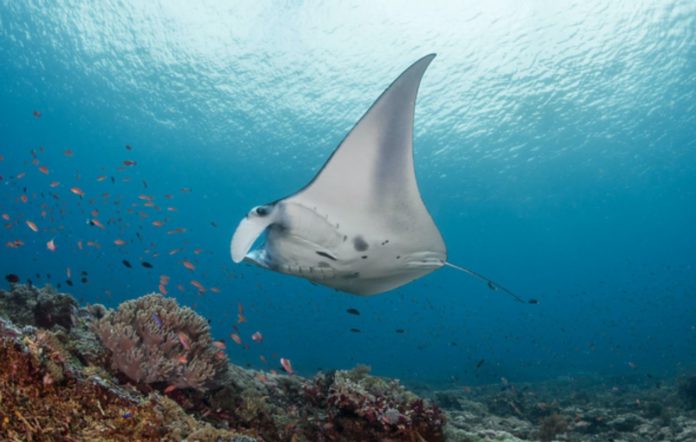Manta rays are popular since they are one of the most well-known species in our waters. Reef mantas (Mobula alfredi), which can reach a length of 5 meters, like to live and feed in shallow coastal environments.
They also go to coral reef ‘cleaning stations,’ where parasites and dead skin are cleaned off by little fish.
Manta rays are found year-round in Komodo National Park, challenging the legendary Komodo dragon as the most sought-after megafauna for visitors.
Scientists from the Marine Megafauna Foundation and Murdoch University have reported a huge number of manta rays in the seas of Komodo National Park, an Indonesian UNESCO World Heritage Site, implying that the area could hold the key to regional recovery of the threatened species.
Scientists collaborated with the Komodo National Park diving operator community to collect identification photos of manta rays visiting the park’s seas and submit them an online database for manta and other rays. The majority of the photos were taken at just four of the more than 20 popular tourist destinations.
“With their support, we were able to identify over 1,000 individual manta rays from over 4,000 photographs,” says lead author Dr. Elitza Germanov
The distinctive and occasionally spectacular abdomen markings of individual manta rays help to identify them. Dr. Andrea Marshall, principal scientist and co-founder of the Marine Megafauna Foundation, saw an opportunity to involve the public in data collection for these threatened and understudied marine animals, so she collaborated with software company WildMe to create MantaMatcher.org, an online wildlife database platform that matches and catalogs manta rays in various populations around the world.
“People love manta rays – they are one of the most iconic animals in our oceans,” adds study co-author Dr. Andrea Marshall, and “the rise of the number of people engaging in SCUBA diving, snorkeling and the advent of affordable underwater cameras meant that photos and videos taken by the public during their holidays could be used to quickly and affordably scale data collection.”
The pictures and associated time and position data are then utilized to create individual manta ray sighting records, which can then be evaluated using statistical movement models. These models can predict whether manta rays will be present at or migrating between specified locations. The findings revealed that some manta rays migrated about the park, while others traveled as far as the Nusa Penida MPA (>450 km to the west), but that manta rays had particular preferences for specific places inside the park.
“I found it very interesting how some manta rays appear to prefer spending their time in some sites more than others, even when sites are 5 km apart, which are short distances for manta rays,” adds Dr. Elitza Germanov. “This means that manta rays which prefer sites where fishing activities continue to occur or that are more popular with tourism will endure greater impacts” she adds.
Since 1984, fishing has been restricted in many coastal parts of Komodo NP, including manta ray habitats, providing manta rays with some protection that precedes the 2014 statewide protection. However, manta rays continue to be threatened by fisheries due to illicit fishing and manta ray movements into heavily fished seas. About 5% of Komodo’s manta rays have lifelong damage, most likely as a result of fishing gear encounters.
Throughout the study, the reputation of Komodo National Park for tourism expanded, resulting in a 34% rise in tourism boats visiting manta ray areas. Increased watercraft activity, as well as excessive diving and snorkeling, can be harmful to manta rays and their habitats. The Komodo National Park Authority set limits on the number of boats and people allowed to visit one of the most well-known manta spots in 2019.
“This study shows that the places where tourists commonly observe manta rays are important for the animals to feed, clean and mate. This means that the Komodo National Park should create measures to limit the disturbance at these sites,” adds Mr. Ande Kefi, an employee of the Komodo National Park involved with this study. “I hope that this study will encourage tourism operators to understand the need for the regulations already imposed and increase compliance,” he adds.
The study’s authors propose additional recommendations for improving manta ray conservation inside Komodo National Park, which can also be applied to other manta ray ecosystems across the world. To reduce the impact of tourism, the number of tourism boats authorized at any given time at all manta ray aggregation areas should be limited, and obligatory standards of conduct for diving and snorkeling with manta rays should be implemented.
Despite Indonesia’s history of extensive manta ray fishing, Komodo National Park still has significant manta ray aggregations that will help regional manta ray populations with careful continuing management and threat reduction. Marine protected areas large enough to house key manta ray habitats, according to the study, are a useful tool for manta ray conservation.
Image Credit: Simon Pierce – Manta on cleaning station
You were reading: Komodo National Park Helping to Retain Large Manta Ray Aggregations
